Menus
- The super athletes on the country road
- MOTORCYCLE scoring
- MOTORRAD test result Landstrasse
- Data: Aprilia, BMW, Ducati
- Data: Honda, Kawasaki, KTM
- Data: MV Agusta, Suzuki, Yamaha
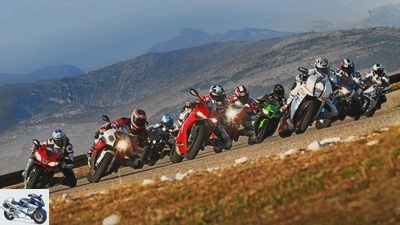
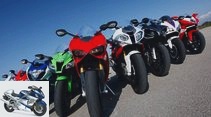
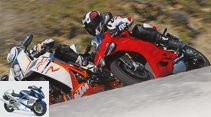
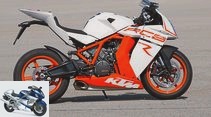
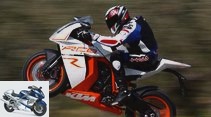
30th photos

1/30
The super athletes: Aprilia RSV4 Factory APRC, BMW S 1000 RR, Ducati 1199 Panigale S, Honda Fireblade, Kawasaki Ninja ZX-10R, KTM 1190 RC8 R, MV Agusta F4 RR, Suzuki GSX-R 1000, Yamaha YZF-R1 in the mega test. Who wins the duel on the country road?
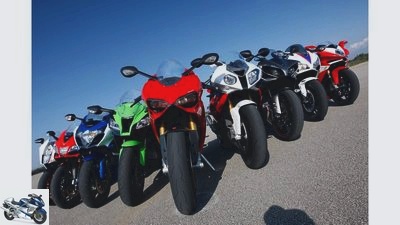
2/30
The super athletes: Aprilia RSV4 Factory APRC, BMW S 1000 RR, Ducati 1199 Panigale S, Honda Fireblade, Kawasaki Ninja ZX-10R, KTM 1190 RC8 R, MV Agusta F4 RR, Suzuki GSX-R 1000, Yamaha YZF-R1.

3/30
Small but nice: the V2 world with the KTM 1190 RC8 R and Ducati 1199 Panigale S..
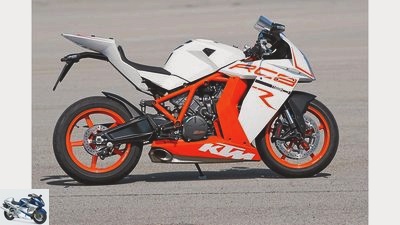
4/30
KTM 1190 RC8 R – The fastest edge in the world: The unconventional design of the RC8 R does not please everyone who is enthusiastic about the beautiful and well thought-out detailed solutions.
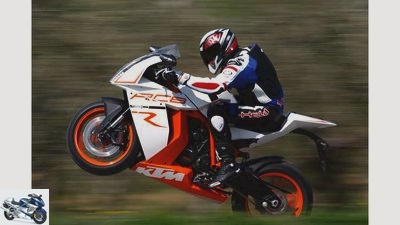
5/30
KTM 1190 RC8 R..
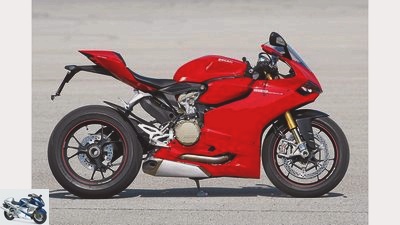
6/30
Ducati 1199 Panigale S – There it rides, the new star in Superbike heaven. With the most powerful V2 of all time, with a revolutionary chassis – and with starting problems. Fortunately, you can’t tell by looking at her.
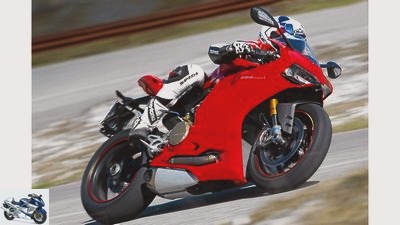
7/30
Ducati 1199 Panigale S..

8/30
Everyday testing: small screw in the fat 200 of the Panigale. It’s rarely found in Italy either.
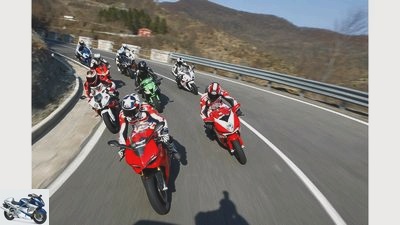
9/30
The super athletes: Aprilia RSV4 Factory APRC, BMW S 1000 RR, Ducati 1199 Panigale S, Honda Fireblade, Kawasaki Ninja ZX-10R, KTM 1190 RC8 R, MV Agusta F4 RR, Suzuki GSX-R 1000, Yamaha YZF-R1.

10/30
Aprilia RSV4 Factory APRC and Yamaha YZF-R1 – four-cylinder with a difference.
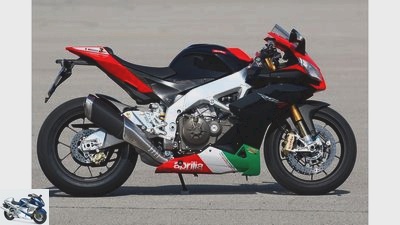
11/30
Aprilia RSV4 Factory APRC – The secret star: The Aprilia RSV4 has matured over the years and, as a factory, not only offers Ohlins spring elements, but also traction control, forged wheels and an automatic gearshift.
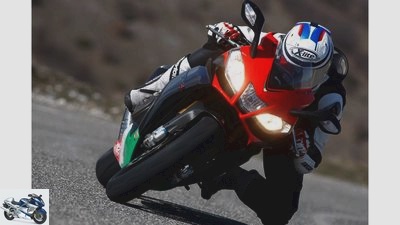
12/30
Aprilia RSV4 Factory APRC.
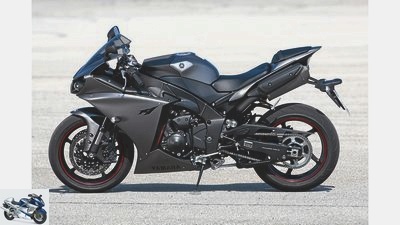
13/30
Yamaha YZF-R1.

14/30
Yamaha YZF-R1.

15/30
The super athletes: Aprilia RSV4 Factory APRC, BMW S 1000 RR, Ducati 1199 Panigale S, Honda Fireblade, Kawasaki Ninja ZX-10R, KTM 1190 RC8 R, MV Agusta F4 RR, Suzuki GSX-R 1000, Yamaha YZF-R1.
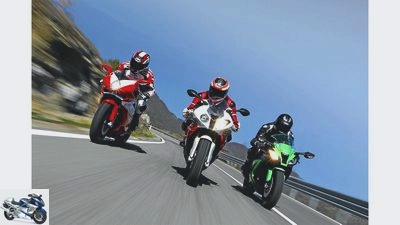
16/30
MV Agusta F4 RR, BMW S 1000 RR and Kawasaki Ninija ZX-10R – the power trio.
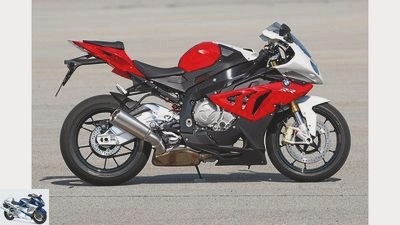
17/30
BMW S 1000 RR – The established power: the new color scheme suits the RR, the revision for 2012 made it even better. Hard to crack by the others.
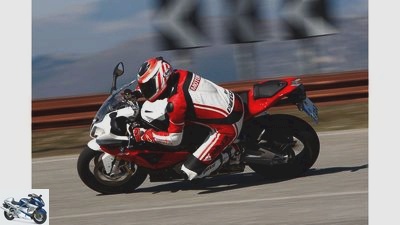
18/30
BMW S 1000 RR.
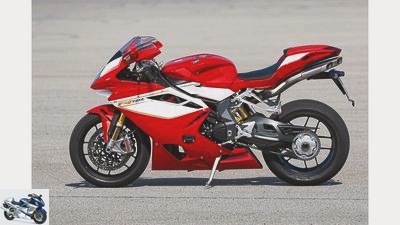
19/30
MV Agusta F4 RR – Eternal beauty: as an RR with Ohlins suspension elements, forged wheels and an extra portion of power. Unfortunately only at the top, beyond 12,000 rpm.
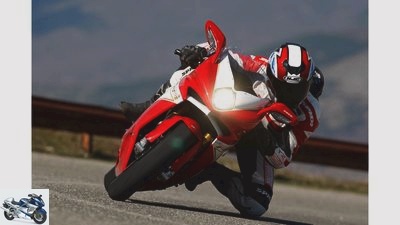
20/30
MV Agusta F4 RR.
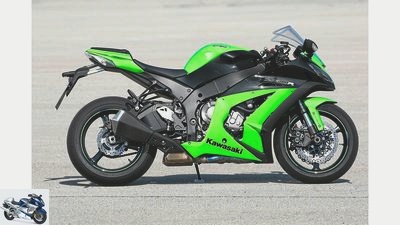
21/30
Kawasaki Ninja ZX-10R – The green danger: The ZX-10R is the complete offer from Japan. ABS, traction control, power in abundance. There is only a lack of pressure in the lower rev range.

22/30
Kawasaki Ninja ZX-10R.
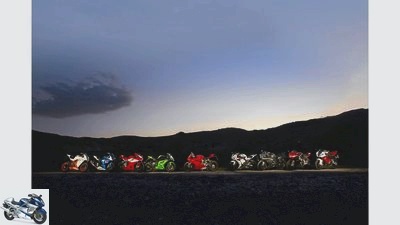
23/30
The super athletes: Aprilia RSV4 Factory APRC, BMW S 1000 RR, Ducati 1199 Panigale S, Honda Fireblade, Kawasaki Ninja ZX-10R, KTM 1190 RC8 R, MV Agusta F4 RR, Suzuki GSX-R 1000, Yamaha YZF-R1.

24/30
GSX-R 1000 and Honda CBR 1000 RR Fireblade – tradition connects.
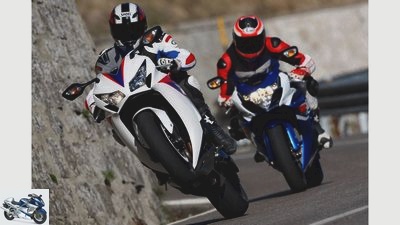
25/30
GSX-R 1000 and Honda CBR 1000 RR Fireblade.

26/30
Honda Fireblade – The Living Legend: No other has been around longer, hardly any so successful. For 2012 with new mapping and new spring elements.
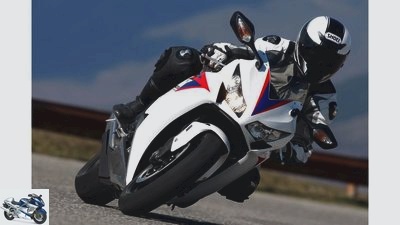
27/30
Honda Fireblade.

28/30
Suzuki GSX-R 1000 – The aging star: The GSX-R has once again polished itself up, entering the race with a revised engine, firmer chassis and new brakes.
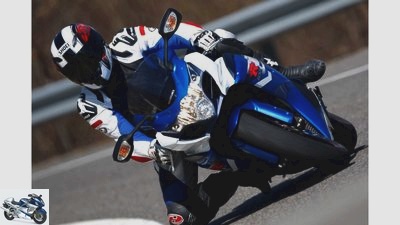
29/30
Suzuki GSX-R 1000.
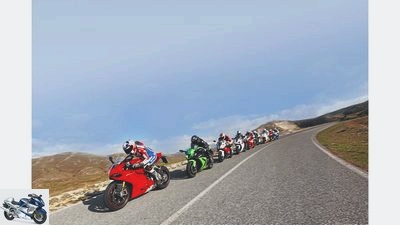
30/30
The winner of the country road test is the BMW S 1000 RR. She defends her title unchallenged and rightly. Nobody combines suitability for everyday use and racing spirit as convincingly as the fast woman from Munich. The new star in Superbike heaven, the Ducati Panigale, is left behind here too.
Comparison test: Superbikes 2012, Aprilia RSV4 Factory, BMW S 1000 RR, Ducati 1199 Panigale S, Honda Fireblade, Kawasaki Ninja ZX-10R, KTM 1190 RC8 R, Suzuki GSX-R 1000, Yamaha YZF-R1 / R1M
The super athletes on the country road
Ducati packs everything that is good and expensive in the new Panigale S, puts together a unique high-tech bundle, and wants to advance into the four-cylinder performance zenith with the V2. Theoretically. In the big MOTORRAD 1000-point test, the new one has to prove itself very practically against the strongest Superbike field of all time.
Do you know what distinguishes an MV Agusta F4 R from one with a double R? What has actually changed in the new Fireblade year apart from the bodywork? Why does the 2012 Suzuki GSX-R 1000 suddenly brake really well? Or that the BMW S 1000 RR now has a shorter gear ratio? You see, all sorts of things went under in the panigale hype.
The new Superbike star from Bologna was simply omnipresent. With an unprecedented high-tech package, it should be able to hold a candle to the four-cylinder engines. First of all, on paper.
But now the time has come. After the top test (MOTORRAD 9/2012), the Panigale faces the competition! Place of first meeting: the holy halls in Bologna. Never before has the handover of a test motorcycle been celebrated more solemnly. The excursion lasts around two hours down to the deepest depths of the electronics menu, chassis options and engine configurations are discussed before the bright red diva finally rolls off the yard. Of course, it is the S version, which costs just under 25,000 euros including ancillary costs, that competes. In contrast to the 5,000 euro cheaper standard version, this means not only the chassis that can be adjusted at the push of a button, but also forged wheels, carbon fenders and, last but not least, the stylish LED headlights.
Kone question, this diva makes an appearance that impresses. A real thunderstorm thunder escapes the exhaust keel in practically every situation, the perfect proportions inspire immediately. Clearly, the Panigale is the unrestricted queen of Italian promenade, even digs a MV Agusta in the extremely expensive RR version (with 200 hp short-stroke engine, Ohlins chassis and forged wheels) the water.
Buy complete article
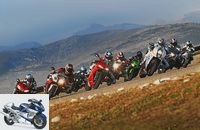
Comparison test: Superbikes 2012
The super athletes on the country road
Ducati sacrifices a lot of the casual pressure from mid-revs in favor of maximum performance. In this context, it is worth looking at the key data of the Panigale in comparison to the second V2 in the field, the RC8 R: 112 millimeters bore (KTM: 105 millimeters) with a stroke of just 60.8 millimeters (KTM: 69 millimeters), incredible throttle valve diameter 68 millimeters (RC8 R: 52 millimeters). These are worlds, especially since the Mattighofener V2 wasn’t exactly designed as a cruiser drive. The incorruptible MOTORRAD test bench shows what this means in terms of measurement technology: After a first energetic start, the new superstar from Bologna actually ran out of air in the medium speed range between 5000 rpm and 7000 rpm. At least in direct comparison with the KTM, whose V2 mutated over the years and after massive interventions (more flywheel, double ignition) from the Rappelbock to the flagship twin. Gassing powerfully and evenly from the lower rev range, massaging your heart and soul – the KTM can do that. The Osi-Twin pushes in second gear even when turning, every straight, no matter how short, becomes an RC8 prey in view of the torque plateau reaching up to 8000 rpm . In return, together with the BMW, it reaps the best pulling power values in the field, while the Panigale hackles with the worst values.
Small but nice: the V2 world with the KTM 1190 RC8 R and Ducati 1199 Panigale S..
In any case, the BMW four-cylinder is still the measure of all things. The performance monster that comes closest to the Ducati engine in terms of its extreme design. A bore of 80 millimeters, a stroke of 49.7 millimeters – like the Bologna Twin, that means a radical class record, a bore-to-stroke ratio aimed solely at maximum performance. And yet the Bavarians succeeded in what the Italians could not do: They pulled out all the stops to control the fresh and exhaust gases, operate with variable intake lengths and exhaust flaps, and also had a shorter translation for the 2012 model year. And the bottom line is not only reaping formidable torque values, but also staying at the forefront of music in the pure acceleration disciplines. But they will naturally not play a central role in this story (even if we do not neglect the performance in the points evaluation), because they are absolutely irrelevant for the enjoyable ride on the home route or the test tour across Italy on the wonderful roads of the Apennines. Later on, on the high-speed track in Nardo (MOTORRAD 13/2012), this aspect will be one of the much discussed. Here it can only be a marginal phenomenon. This is a shame for the Panigale, which in turn proves the high levels of performance that a V2 that has been consistently trimmed to power is capable of. 190 hp at 10,600 rpm – that is indeed a fabulous two-cylinder value, with the exception of the performance giants from BMW (200 hp at 13,100 rpm), Kawasaki (197 hp at 13,000 rpm) and MV Agusta (190 PS at 13200 / min) everyone else and especially the KTM (174 PS at 8300 / min) firmly under control. Nevertheless, the test bench curve shows what strange shapes striving for the highest possible peak performance can take.
In the middle, deep in the performance hole and brushed by the KTM, beaten at the top by the BMW – the strength of the V2 engine is probably more on the race track than on the home track.
Especially since there is a second circumstance that is not convincing when dealing with the red diva on a daily basis, despite all the fascination that this radically new concept exudes. In addition to the engine characteristics, the throttle response – or rather what the control electronics and the servomotor do from the commands of the throttle hand – are definitely in need of improvement. In the basement, what is required at the right handlebar end is sometimes only implemented with a slight delay. True to the motto: the driver steers, the computer thinks. In addition to the ride-by-wire-controlled Yamaha (very hard throttle response, but finely adjustable power input), the Aprilia (soft and precise), which had to struggle with similar problems when it was launched, shows how it can be done better.
In general, Aprilia and Yamaha. Or, if you will, the alternative concepts to the new high-speed V2. Both with their very own characterful V4 charm (which the Yamaha imitates convincingly by means of crank pin and ignition offset) and the bottom line is also with respect to the engine with considerable, albeit different, qualities. The Yamaha in-line quad starts incredibly strong, is practically from idle, has around 4000 rpm, where especially the Fireblade and the MV Agusta treat themselves to a nightcap, a period of excessive creative power. After that it slackens noticeably, but by no means in Ducati dimensions, and, like the V4 from Noale, pushes into the five-digit speed range with finely calculable evenness and nonchalance. The Ducati V2 is completely different. When it snaps back properly from 7000 rpm, it’s both a pleasure and a challenge. The parallels to the other high-performance concepts of the BMW S 1000 RR, the Kawasaki ZX-10R and the MV Agusta F4 RR, which also really reach above, cannot be overlooked. With the difference that here the point that separates the wheat from the chaff comes much later and not quite as violently. And when – see MV – it is only 12,000 rpm to still reach the 190 PS mark. But, as mentioned, this unicycle scenario takes place in speed regions that are also prohibited in Italy and highly dangerous in the Apennines.
Aprilia RSV4 Factory APRC and Yamaha YZF-R1 – four-cylinder with a difference.
Below, in the four-digit range, however, there are differences in temperament that one would not expect with so many concept-related similarities. In short: lively and always on the go, the BMW, of rather restrained creative power, the Kawa and MV. For very different reasons. While the restrained performance of the 10 series in combination with the long, top-speed gear ratio causes displeasure, the F4 RR is not only designed to be shorter than the standard F4 of the past, but also has a significantly shorter gear ratio. Over 300 km / h, like last year in Nardo, are no longer possible, the throughputs are now noticeably better. And yet: The F4 is almost reluctant to accelerate and, like the Kawa, always seems a bit strained.
Especially when the “conventional” four-cylinder models are used in a direct comparison, the Fireblade and the GSX-R 1000. Both new for 2012 – and both just revised. At least as far as the engine is concerned, in which Honda only changed the injection mapping in order to make the throttle response smoother, while Suzuki lend a hand on the camshafts, crank drive, engine management and exhaust, but still does not promise any performance miracles. From a marketing point of view, this may be a disappointment (the rated power is “only” 178 or 185 hp). In terms of everyday life and country roads, however, both the Honda and the Suzuki prove from every corner that top performance means nothing, decent torque in combination with a successful translation and controllable throttle response means almost everything. You never, really never feel underpowered on these two. The occasions, however, when you are happy about the full punch from the lower revs (Suzuki) or mid-revs (Honda), truly feel on big bikes and casually set the pace with your wrist are all the more numerous. You forgive the Honda for its 4000 weakness, which was still present and could not be remedied by a new mapping. Just as you don’t take the Suzuki’s hard throttle response crookedly. For the fact that these two do not exude the unconditional sporting spirit of a BMW or Ducati, one would sometimes even want to be grateful to the engines during the courageous curve milling.
Just like Ducati for the courage to break new ground in terms of chassis technology with the Panigale: the engine as a supporting element, to which the steering head and the rear frame are screwed. We haven’t had that in Superbike circles. Neither do the Ohlins spring elements that can be adjusted at the push of a button. In addition, a large number of mapping, ABS and traction control variants, automatic gearshift and, last but not least, a modern multi-color display with an iPhone look and more functions than the driver will ever need. In fact, it doesn’t offer more features, nor less weight. 195 kilograms with a full tank is a class record, with a full five kilograms between the Kawa and the KTM. Also extreme: the chassis set-up, which consistently leaves the civilian sector outside. Hard as a board – there is no other way of describing what the Ohlins shock absorber delivers in terms of suspension comfort despite all the adjustment options. The chassis people from Bologna should take an example from Aprilia or MV, because both the RSV4 and the F4 show that a tight set-up can be accompanied by a decent amount of residual comfort. At the front, on the other hand, the Swedish technicians have done a great job, the fork is extremely responsive and, in combination with the super sporty Pirelli Supercorsa SP (rear in the new 200 trend format), delivers crystal-clear feedback. In addition, there is ergonomics that are tolerable in everyday life and that are far more comfortable than their predecessor. The wide handlebar halves and the short tank are also a factor that, together with the record weight of 195 kilograms, has such a significant influence on handling that one can say: Great, no Ducati has turned so easily. It is really remarkable. It might even be sensational if there wasn’t someone else in the test field who acts like someone from another planet in this regard.
The Aprilia RSV4 Factory proves two things once again. On the one hand, that their concept with a narrow 65-degree V4, which can be positioned very centrally in the aluminum bridge frame, gives the chassis technicians all options to put a finely balanced and excellently functioning motorcycle on its wheels. And secondly, that weight does not necessarily have to be the determining factor in terms of handling quality. The RSV4 weighs 205 kilograms with a full tank of fuel exactly ten kilograms more than the Ducati, five more than a ZX-10R and even two more than the new GSX-R 1000. And yet no one falls as playfully into an incline as the Aprilia, no one lets itself be like that Steer precisely, don’t drive tighter lines or let yourself be thrown into corners with so much verve on the brakes. All in all, an almost unbelievable idea, especially since these properties are paired with unshakable stability. As a result, the RSV4 – in the factory version as well as the Panigale equipped with Ohlins spring elements, forged wheels, perfectly functioning traction control and the best gearshift in the field – is far ahead of all others in the chassis classification. In view of these qualities, it is no wonder that it conveys that GP feeling so closely and authentically like no other. Just like in real racing, the driver shouldn’t be too big, because otherwise he’ll run out of space on the petite Aprilia.
MV Agusta F4 RR, BMW S 1000 RR and Kawasaki Ninija ZX-10R – the power trio.
However, when it comes to feeling real, the S 1000 RR sits tight on the neck. Even here in the Apennines, at the away game. The ease with which the Munich resident combines two worlds as different as the maximum race spirit and the excellent suitability for everyday use is admirable. Mastering this balancing act is certainly easier with a four-cylinder. Not just in terms of the engine. The chassis and ergonomics are in no way inferior in this regard. Get on, drive off, be amazed – the S 1000 RR experience can be reduced to this short formula in view of the greed with which the BMW rushes on routes of all stripes. Every small twitch of the gas hand is implemented one to one, the feedback from the Sachs spring elements is clear, the steering behavior is neutral even in the deepest lean angles, the braking system is brutal and yet extremely finely dosed. In addition, there is everything that electronics pioneer BMW gave the S 1000 RR two years ago. An ABS that is suitable for racing and everyday use, an equally conditioned traction control and the option of using both, combined with different mapping variants in four stages, at the push of a button from the right handlebar end while driving. Seriously: Nobody needs more – and at BMW it is still available as an option. Because the Bavarians were also pioneers when it comes to automatic switchgear, and they still are with heated grips. For a small surcharge, warm fingers even on the highest passes, that’s something. And yet, at 17,891 euros for the test motorcycle, the BMW is a bargain considering the 24,990 euros for a Panigale S or 22,590 euros for an Aprilia Factory.
The same applies to the KTM since Mattighofen drastically lowered the price of the RC8 R. Almost 16,300 euros – that’s not a lot of money for a motorcycle with this quality of workmanship, these inspiring details, this variability and the levers that can be adjusted in every respect. Especially when, as with the RC8 R, in addition to the really great V2, the chassis has also reached a level of maturity that would never have been expected of it at its bumpy birth (even KTM back then relied on a strut that was much too hard). Handy, neutral, precise, and blessed with perfect road ergonomics and great brakes, the KTM inspires the entire test crew, making fast driving easier than almost any other. The only thing missing: modern assistance systems such as ABS and traction control. These are currently not available in Mattighofen for money and good words, which not only costs points and high-tech fascination à la Panigale, but should also be a real exclusion criterion for many with regard to a possible resale.
Of course, this does not apply to the similarly priced Kawasaki ZX-10R (test motorcycle price: 16,495 euros). It is Nippon’s first serious response to the European high-tech offensive. Measured 197 hp, also only weighs 200 kilograms and with everything on board that superbike technology currently has to offer, the Kawa is a size to be taken seriously. However, so far there has been no getting around BMW when it comes to leading the pack of four. This was mainly due to the poor engine performance in the lower and middle speed range, while the chassis certainly keeps what sports drivers expect from it. Basically nothing has changed in this regard in the current model year.
What has changed is what the competitors have to offer, who have added seasoning. Above all the BMW. More midrange power, more cushioning, better handling – even small changes can have a lasting effect in this fast-moving business. Would you like another example? The ZX-10R was the only one of the Bridgestone-tyred Japan trio Honda / Kawasaki / Suzuki to keep the aged BT 016 as the first tire on the rims, while the other two Nippon daughters converted to the new, much more homogeneous S 020 as part of their facelift. With noticeable effects on the stability and accuracy, because the 016 is still inappropriately on every bump, every pothole and the Italian country roads have a lot of these faults to offer.
The S 020, on the other hand, glides elegantly over this adversity with its better self-damping and turns both the new Fireblade and the GSX-R 1000 into good, no, really good country road sweeps. Especially when it is used in chassis that no longer follow the Japanese tendency to compromise as unconditionally as in the past. Suzuki in particular went on the offensive here, giving the now finely appealing Big Piston Fork from Showa, which is also used in the Fireblade with a slightly more comfortable design, a firmer cushioning. Both of them also retuned their shock absorbers, with the Honda being a little too soft and the Suzuki a little too hard. And yet: Dedicated heating on the border between the road traffic regulations and the criminal code can both tolerate without complaint. However, the renunciation of traction control (Honda) weighs heavily, the ABS and traction control (Suzuki) are even more difficult, especially since the GSX-R with new Brembo monobloc saddles and other pads turned the braking mishap of the past into its opposite. Ergonomics remains a construction site for both. The footpegs on the Honda are still too far forward and too high up, while on the Suzuki the wide tank spreads its legs out of date.
GSX-R 1000 and Honda CBR 1000 RR Fireblade – tradition connects.
In this regard, both could learn from Yamaha. Ergonomically, the R1, which in this model year has at least partially jumped on the high-tech train with a well-functioning traction control, is way ahead. In addition, an engine that is made for the country road, in a chassis that is the only one in the field that deliberately focuses on comfort and also combines this characteristic with great neutrality, fine handling and comfortable ergonomics. Equipped with a modern ABS and a better braking system (which is the only one in the field that acts extremely bluntly), the R1 could end up much further ahead in the points classification. In the hearts of the test crew, she already does, despite her chubby appearance.
With the last member of the league, the MV, it is the other way around. She is loved because of her beauty – and hated because of her ergonomics and the stubbornness with which she opposes every change of direction. Anyone who cannot cope with the long tank and the deep handlebars and prefers gentle instructions instead of clear announcements will not be reconciled by the well-functioning and not too hard -Ohlins chassis. And those who cannot come to terms with the delayed and unwilling throttle response (this construction site will probably not be resolved in Varese in 100 years) will not appreciate the last bit of peak performance that the MV delivers beyond 12,000 rpm conjures up her hat. It doesn’t matter anymore that it has great brakes but no ABS. Or that their so-called traction control does not work and the gearbox of the RR did not improve after the revision (the first three and the last gear longer) with long shift travel. The hoarse sound, on the other hand, still impresses at least as much as the great appearance, the mighty price and the manageable score. Which somehow closes the circle to Panigale in the end. Until the next showdown on the racetrack.
MOTORCYCLE scoring
The super athletes: Aprilia RSV4 Factory APRC, BMW S 1000 RR, Ducati 1199 Panigale S, Honda Fireblade, Kawasaki Ninja ZX-10R, KTM 1190 RC8 R, MV Agusta F4 RR, Suzuki GSX-R 1000, Yamaha YZF-R1.
engine
Four in a row beats V2 or: a defeat across the board. Ducati’s interpretation of the strong twin has to stand behind in everyday life, while the four-cylinder from Suzuki and BMW show off. The KTM engine delivers a very strong performance for a V2, while the MV muscle man like the Ducati V2 only has pressure on top.
Winner engine: Suzuki
landing gear
One thing for Aprilia or: The Ducati is defeated here too. The gap to the phenomenal RSV4 is extremely clear, and that to the BMW cannot be overlooked. Above all, the set-up of the shock absorber is far too hard, at least for the country road, while comfort on the Yamaha is just right here. And again the BMW manages a convincing balancing act.
Winner chassis: Aprilia
everyday life
The seating comfort – a clear case for KTM, none is so variable, there is no so much space. The extensive equipment, however, is the domain of the Kawasaki, the range because of the low consumption is basically a Japanese flagship chapter that only Yamaha fails. And when it comes to processing, none of the MV can hold a candle.
Winner everyday: Kawasaki
security
Even with the superbikes, nothing works without ABS. Imagine that everyone had the anti-lock device. That would move a lot. The best brakes are BMW and Ducati, which landed here in second place.
Safety winner: Honda
costs
Again: Japan dominates in consumption. And one traditionally drinks like a hole: the MV.
Winner costs: BMW
Price-performance
In terms of this exclusive superbike field, the inexpensive Suzuki is just ahead of the Honda.
Price-performance winner: Suzuki
| Max. score |
Aprilia | BMW | Ducati | Honda | Kawasaki | KTM | MV Agusta | Suzuki | Yamaha | engine | 250 | 208 | 214 | 192 | 208 | 202 | 202 | 195 | 216 | 208 |
| landing gear | 250 | 205 | 198 | 193 | 195 | 193 | 192 | 190 | 187 | 197 | everyday life | 250 | 124 | 137 | 125 | 129 | 139 | 134 | 115 | 132 | 130 |
| security | 150 | 93 | 112 | 113 | 115 | 107 | 91 | 96 | 92 | 87 | costs | 100 | 48 | 55 | 49 | 47 | 49 | 49 | 33 | 49 | 46 |
| Overall rating | 1000 | 678 | 716 | 672 | 694 | 690 | 668 | 629 | 676 | 668 | placement | 4th. | 1. | 6th. | 2. | 3. | 7th. | 9. | 5. | 7th. |
| Price-performance note | 1.0 | 4.0 | 2.7 | 4.0 | 2.6 | 2.7 | 3.0 | 4.0 | 2.5 | 2.9 |
MOTORRAD test result Landstrasse
The winner of the country road test is the BMW S 1000 RR. She defends her title unchallenged and rightly. Nobody combines suitability for everyday use and racing spirit as convincingly as the fast woman from Munich. The new star in Superbike heaven, the Ducati Panigale, is left behind here too.
1.BMW S 1000 RR
She defends her title unchallenged and rightly. Nobody combines suitability for everyday use and racing spirit as convincingly as the fast woman from Munich.
2. Honda Fireblade
Their balance is their strength. Except in the chapter on safety (because of the great ABS), nowhere at the top, the facelifted Fireblade scores consistently.
3. Kawasaki ZX-10R
The green racer went down one place because the Fireblade was catching up. But the others have also come closer.
4. April RSV4 Factory
The engine is an experience, the chassis a stunner, in everyday life and in terms of safety (ABS!) It cannot (yet) shine. Otherwise she would be right at the front.
5. Suzuki GSX-R 1000
And another one that did the facelift good. However, with a great engine, but without assistance systems, it is clearly past the trend.
6. Ducati 1199 Panigale S.
The extreme design costs valuable points in everyday operation. Still a huge step forward compared to the previous 1198 model.
7. KTM 1190 RC8 R
And another one who messes up the refusal of the tour. Aside from ABS and traction control, the KTM is a great motorcycle. And your engine the better V2.
8. Yamaha YZF-R1
Again: without ABS – that is no longer appropriate. The rest, however, fits. As with the KTM. Even the entertainment value is similarly high.
9th MV Agusta F4 RR
No, the ABS alone would not help the MV significantly. Just like the icing on the cake of top performance. A case for fans!
archive
The performance diagram of the super athlete. Power on the crankshaft. Measurements on Dynojet roller test stand 250, corrected according to 95/1 / EG, maximum possible deviation ± 5%.
Aprilia RSV4 Factory APRC
Nowhere outstanding, but everywhere predictable: The entertainment value of the V4 is far higher than the performance curve suggests. A great superbike engine.
BMW S 1000 RR
Outstanding at the top, always good in between: The Bavarian powerhouse sets the standards for the four-cylinder and also turns on sound-wise.
Ducati 1199 Panigale S.
Above top, bottom flop: The new Ducati V2 has a weak period in the middle speed range. From 7000 revs it bites mercilessly and outperforms most four-cylinder engines at the top.
Honda Fireblade
A hole at 4000 rpm, then it really goes off. The problem area of the Panigale V2 is the showcase area of the Fireblade engine. The air becomes thinner at the top.
Kawasaki Ninja ZX-10R
Even if you don’t really see it in this tangle of curves: the Kawa engine is a real disappointment down below. Then there is a bang at the top.
KTM 1190 RC8 R.
The alternative to the Panigale: no V2, no engine at all, can be much better and more linear.
MV Agusta F4 RR
You can hardly see it, the MV curve. Except for the trailer between 3000 and 4000 rpm. And the top out.
Suzuki GSX-R 1000
The power can be used splendidly between 3500 and 6000 rpm. A real everyday engine with almost no problems.
Yamaha YZF-R1
Like the Aprilia-V4, a completely different world of emotions. The R1 engine boils down the four-cylinder up to 4500 rpm, then a little more restrained.
Data: Aprilia, BMW, Ducati
BMW S 1000 RR.
| Aprilia | BMW | Ducati | engine |
| design type | Four cylinder 65 degree V engine | Four-cylinder in-line engine | Two cylinder 90 degree V engine | injection | Ø 48 mm | Ø 48 mm | Ø 68 mm |
| coupling | Multi-disc oil bath clutch (Anti-hopping) |
Multi-disc oil bath clutch (Anti-hopping) |
Multi-disc dry clutch (Anti-hopping) |
Bore x stroke | 78.0 x 52.3 mm | 80.0 x 49.7 mm | 112.0 x 60.8 mm |
| Displacement | 1000 cm3 | 999 cm3 | 1198 cm3 | compression | 13.0: 1 | 13.0: 1 | 12.5: 1 |
| power | 132.4 kW (180 PS) at 12500 rpm |
142.0 kW (193 hp) at 13,000 rpm |
143.0 kW (195 hp) at 10750 rpm |
Torque | 115 Nm at 10000 rpm | 112 Nm at 9750 rpm | 132 Nm at 9000 rpm |
| landing gear | frame | Bridge frame made of aluminum | Bridge frame made of aluminum | Aluminum monocoque |
| fork | Upside-down fork, Ø 43 mm | Upside-down fork, Ø 46 mm | Upside-down fork, Ø 43 mm | Steering damper | hydraulically | hydraulically | hydraulically |
| Brakes front / rear | Ø 320/220 mm | Ø 320/220 mm | Ø 330/245 mm | Assistance systems | Traction control | ABS / traction control | ABS / traction control |
| bikes | 3.50 x 17; 6.00 x 17 | 3.50 x 17; 6.00 x 17 | 3.50 x 17; 6.00 x 17 | tires | 120/70 ZR 17; 200/55 ZR 17 | 120/70 ZR 17; 190/55 ZR 17 | 120/70 ZR 17; 200/55 ZR 17 |
| Tires | Pirelli Diablo Super Corsa SP, front “C” |
Metzeler Racetec K3 Interact | Pirelli Supercorsa SP | Dimensions + weights |
| wheelbase | 1420 mm | 1423 mm | 1437 mm | Steering head angle | 65.5 degrees | 66.0 degrees | 65.5 degrees |
| trailing | 105 mm | 99 mm | 100 mm | Front / rear suspension travel | 120/130 mm | 120/130 mm | 120/130 mm |
| Seat height ** | 840 mm | 810 mm | 820 mm | Weight with full tank ** | 205 kg | 209 kg | 195 kg |
| Payload ** | 201 kg | 196 kg | 175 kg | Tank capacity / reserve | 17.0 liters | 17.5 liters | 17.0 liters |
| Service intervals | 10,000 km | 10,000 km | 12,000 km | price | 22590 euros | 16 100 euros | 24 490 euros |
| Price test motorcycle | 22590 euros | 17 891 euros *** | 24 490 euros | Additional costs | around 287 euros | around 264 euros | around 345 euros |
| MOTORCYCLE readings | Top speed * | 290 km / h | 299 km / h | 296 km / h |
| acceleration | 0-100 km / h | 3.2 sec | 3.2 sec | 3.2 sec |
| 0-140 km / h | 4.5 sec | 4.6 sec | 4.6 sec | 0-200 km / h | 7.5 sec | 7.2 sec | 7.6 sec |
| Draft | 60-100 km / h | 3.7 sec | 3.3 sec | 3.9 sec |
| 100-140 km / h | 3.5 sec | 3.0 sec | 3.6 sec | 140-180 km / h | 3.4 sec | 3.0 sec | 4.7 sec |
| consumption | Consumption highway | 6.1 liters, super | 5.6 liters, super / plus | 6.1 liters, super |
| Reach country road | 279 km | 313 km | 279 km |
* Manufacturer information; ** MOTORCYCLE measurements; *** including ABS and DTC (1230 euros), automatic gearshift (364 euros) and heated grips (197 euros); **** incl. racing windshield (120 euros); ***** including ABS (1000 euros)
Data: Honda, Kawasaki, KTM
KTM 1190 RC8 R..
| Honda | Kawasaki | KTM | engine |
| design type | Four-cylinder in-line engine | Four-cylinder in-line engine | Two cylinder 75 degree V engine | injection | Ø 46 mm | Ø 47 mm | Ø 52 mm |
| coupling | Multi-disc oil bath clutch (Anti-hopping) |
Multi-disc oil bath clutch (Anti-hopping) |
Multi-disc oil bath clutch | Bore x stroke | 76.0 x 55.1 mm | 76.0 x 55.0 mm | 105.0 x 69.0 mm |
| Displacement | 1000 cm3 | 998 cm3 | 1195 cm3 | compression | 12.3: 1 | 13.0: 1 | 13.5: 1 |
| power | 130.7 kW (178 hp) at 12,000 rpm |
147.0 kW (200 hp) at 13,000 rpm |
129.0 kW (175 hp) at 10250 rpm |
Torque | 112 Nm at 8500 rpm | 112 Nm at 11500 rpm | 127 Nm at 8000 rpm |
| landing gear | frame | Bridge frame made of aluminium |
Bridge frame made of aluminium |
Tubular space frame from steel |
| fork | Upside-down fork, Ø 43 mm |
Upside-down fork, Ø 43 mm |
Upside-down fork, Ø 43 mm |
Steering damper | electronic / hydr. | hydraulically | hydraulically |
| Brakes front / rear | Ø 320/220 mm | Ø 310/220 mm | Ø 320/220 mm | Assistance systems | SECTION | ABS / traction control | – |
| bikes | 3.50 x 17; 6.00 x 17 | 3.50 x 17; 6.00 x 17 | 3.50 x 17; 6.00 x 17 | tires | 120/70 ZR 17; 190/50 ZR 17 | 120/70 ZR 17; 190/55 ZR 17 | 120/70 ZR 17; 190/55 ZR 17 |
| Tires | Bridgestone S 20 “G” | Bridgestone BT 016 “CC” | Dunlop Sportsmart | Dimensions + weights |
| wheelbase | 1410 mm | 1425 mm | 1425 mm | Steering head angle | 66.8 degrees | 65.0 degrees | 66.7 degrees |
| trailing | 96 mm | 107 mm | 97 mm | Front / rear suspension travel | 120/135 mm | 120/125 mm | 120/120 mm |
| Seat height ** | 830 mm | 810 mm | 820-840 mm | Weight with full tank ** | 209 kg | 200 kg | 205 kg |
| Payload ** | 170 kg | 178 kg | 175 kg | Tank capacity / reserve | 17.7 liters | 17.0 liters | 16.5 liters |
| Service intervals | 6000 km | 6000 km | 7500 km | price | 15,990 euros | 15 495 euros | 16 295 euros |
| Price test motorcycle | 16 110 euros **** | 16 495 euros ***** | 16 295 euros | Additional costs | around 295 euros | around 170 euros | around 200 euros |
| MOTORCYCLE readings | Top speed * | 293 km / h | 295 km / h | 287 km / h |
| acceleration | 0-100 km / h | 3.1 sec | 3.3 sec | 3.2 sec |
| 0-140 km / h | 4.5 sec | 4.6 sec | 4.8 sec | 0-200 km / h | 7.4 sec | 7.3 sec | 8.2 sec |
| Draft | 60-100 km / h | 3.6 sec | 3.9 sec | 3.1 sec |
| 100-140 km / h | 3.4 sec | 3.5 sec | 3.2 sec | 140-180 km / h | 3.0 sec | 3.6 sec | 3.3 sec |
| consumption | Consumption highway | 5.1 liters, super | 5.1 liters, great | 5.6 liters, super / plus |
| Reach country road | 347 km | 333 km | 295 km |
* Manufacturer information; ** MOTORCYCLE measurements; *** including ABS and DTC (1230 euros), automatic gearshift (364 euros) and heated grips (197 euros); **** incl. racing windshield (120 euros); ***** including ABS (1000 euros)
Data: MV Agusta, Suzuki, Yamaha
Yamaha YZF-R1.
| MV Agusta | Suzuki | Yamaha | engine |
| design type | Four-cylinder in-line engine | Four-cylinder in-line engine | Four-cylinder in-line engine | injection | Ø 46 mm | Ø 44 mm | Ø 45 mm |
| coupling | Multi-disc oil bath clutch (Anti-hopping) |
Multi-disc oil bath clutch (Anti-hopping) |
Multi-disc oil bath clutch (Anti-hopping) |
Bore x stroke | 79.0 x 50.9 mm | 74.5 x 57.3 mm | 78.0 x 52.2 mm |
| Displacement | 998 cm3 | 999 cm3 | 998 cm3 | compression | 13.4: 1 | 12.8: 1 | 12.7: 1 |
| power | 147.7 kW (200 PS) at 13400 rpm |
136.0 kW (185 hp) at 11500 rpm |
133.9 kW (182 PS) at 12500 rpm |
Torque | 114 Nm at 9200 rpm | 117 Nm at 10000 rpm | 116 Nm at 10000 rpm |
| landing gear | frame | Tubular space frame from steel |
Bridge frame made of aluminium |
Bridge frame made of aluminium |
| fork | Upside-down fork, Ø 43 mm |
Upside-down fork, Ø 43 mm |
Upside-down fork, Ø 43 mm |
Steering damper | hydraulically | electronic / hydr. | electronic / hydr. |
| Brakes front / rear | Ø 320/210 mm | Ø 310/220 mm | Ø 310/220 mm | Assistance systems | Traction control | – | Traction control |
| bikes | 3.50 x 17; 6.00 x 17 | 3.50 x 17; 6.00 x 17 | 3.50 x 17; 6.00 x 17 | tires | 120/70 ZR 17; 190/55 ZR 17 | 120/70 ZR 17; 190/50 ZR 17 | 120/70 ZR 17; 190/55 ZR 17 |
| Tires | Pirelli Supercorsa SP | Bridgestone S 20 “F” | Michelin Power Pure, front “A” | Dimensions + weights |
| wheelbase | 1430 mm | 1405 mm | 1415 mm | Steering head angle | 66.0 degrees | 66.5 degrees | 66.0 degrees |
| trailing | 100 mm | 98 mm | 102 mm | Front / rear suspension travel | 120/120 mm | 120/130 mm | 120/120 mm |
| Seat height ** | 830 mm | 810 mm | 820 mm | Weight with full tank ** | 213 kg | 203 kg | 214 kg |
| Payload ** | 182 kg | 182 kg | 181 kg | Tank capacity / reserve | 17.0 liters | 17.5 liters | 18.0 liters |
| Service intervals | 6000 km | 6000 km | 10,000 km | price | 22 900 euros | 14 790 euros | 15 750 euros |
| Price test motorcycle | 22 900 euros | 14 790 euros | 15 750 euros | Additional costs | around 275 euros | around 220 euros | around 295 euros |
| MOTORCYCLE readings | Top speed * | 298 km / h | 295 km / h | 285 km / h |
| acceleration | 0-100 km / h | 3.4 sec | 3.2 sec | 3.3 sec |
| 0-140 km / h | 4.9 sec | 4.5 sec | 4.7 sec | 0-200 km / h | 7.8 sec | 7.5 sec | 7.8 sec |
| Draft | 60-100 km / h | 3.9 sec | 3.4 sec | 3.5 sec |
| 100-140 km / h | 3.4 sec | 3.1 sec | 3.5 sec | 140-180 km / h | 3.2 sec | 3.2 sec | 3.6 sec |
| consumption | Consumption highway | 6.8 liters, super | 5.0 liters, super | 6.0 liters, super |
| Reach country road | 250 km | 350 km | 300 km |
* Manufacturer information; ** MOTORCYCLE measurements; *** including ABS and DTC (1230 euros), automatic gearshift (364 euros) and heated grips (197 euros); **** incl. racing windshield (120 euros); ***** including ABS (1000 euros)
Related articles
-
Superbikes 2012 – The super athletes on the high-speed track
18th photos 1/18 The super athletes: Aprilia RSV4 Factory APRC, BMW S 1000 RR, Ducati 1199 Panigale S, Honda Fireblade,…
-
2017 super sports car in the country road comparison test
fact 28 pictures factstudio.de 1/28 The 2017 superbikes were just dueling on the racetrack, now the focus is on the country road …
-
Comparison test of superbikes, part 1: Country road
Jorg Kunstle 36 pictures 1/36 Comparison test Superbikes: Aprilia RSV4 RF, BMW S 1000 RR, Kawasaki ZX-10R, Yamaha YZF-R1M. 2/36 …
-
Test of the Superbikes 2012 – The super athletes on the racetrack
Jahn 26 pictures Jahn 1/26 The super athletes: Aprilia RSV4 Factory APRC, BMW S 1000 RR, Ducati 1199 Panigale S, Honda Fireblade, Kawasaki Ninja ZX-10R, KTM …
-
Seven superbikes in the comparison test – country road
r-photography.info 37 photos r-photography.info 1/37 Aprilia RSV4 RF, BMW S 1000 RR, Ducati Panigale V4 S, Honda CBR 1000 RR Fireblade SP, Kawasaki Ninja…
-
The best athletes in the country road comparison Honda CBR 600 F, Suzuki GSX-R 750, Kawasaki ZX-9R, Aprilia RSV Mille, Suzuki GSX 1300 R Hayabusa …
-
The super sports mega test part 1: Country road
Kuenstle 82 pictures Kuenstle 1/82 Easy to use traction control of the Aprilia. Kuenstle 2/82 A thoroughbred racing file with incredible handling ….
-
600 super sports car: Motorcycles tested in 2012 – with suspension settings
Jahn 33 pictures Jahn 1/33 Supersports 2012 in comparison: Honda CBR 600 RR, Kawasaki Ninja ZX-6R, MV Agusta F3 675, Suzuki GSX-R 600, Triumph Daytona 675 …
-
Comparison test: superbikes on the country road
Jahn 23 pictures Aprilia 1/23 Max Biaggi has already achieved some successes in the Superbike World Championship with his Aprilia RSV4. Aprilia 2/23 Aprilia 3/23 …
-
A comparison of the athletes at the 2012 Alpine Masters
Jahn 17 pictures Jahn 1/17 BMW S 1000 RR: Despite the taut chassis, the BMW offers excellent feedback. However, a noticeable setup moment is …